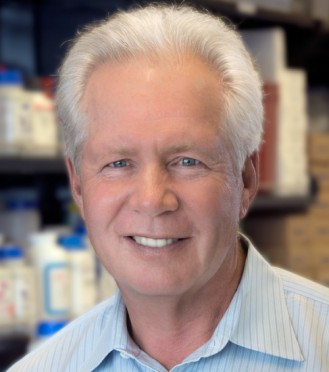Gladstone NOW: The Campaign Join Us on the Journey✕

Individuals are required to wear a mask and adhere to physical distancing while they work inside the Gladstone building.
Even as the coronavirus continues to spread through the country at an alarming rate, too many individuals are still refusing to wear a mask.
Why does it matter? The United States has had nearly 4 million confirmed cases of COVID-19, more than any other country in the world. To date, over 158,000 people in the US have died from the disease—more than the number of American troops who lost their lives in World War I.
And the situation is only going to get bleaker.
“We have to get control of this virus or it will just rip through our communities,” says expert virologist Warner Greene, MD, PhD, a senior investigator at Gladstone Institutes. “It’s almost assuredly true that it’s going to get worse in the fall and early winter when we start mixing this virus with the seasonal flu.”
While other countries are successfully managing this outbreak, it keeps getting worse in the US, in large part because the virus is being politicized.
The COVID-19 pandemic is not a time for politics. This common threat should bring us together as one, not divide us. Yet, many Americans are choosing not to wear a face mask as a way of expressing a political stance.
Each of us must separate our political views and affiliations from the serious public health crisis we are facing as a nation. If we want to continue to exercise the freedoms we have, we must take seriously our responsibility to protect ourselves, our families, and by extension, our communities. And without a universal mask order, the onus falls upon each individual to follow public health guidelines.
As Anthony Fauci, director of the National Institute of Allergy and Infectious Diseases, recently told The New York Times, these guidelines “should be followed and appreciated as the vehicle to open the country, as opposed to the obstacle to opening the country.”
“As a country, we should have two main goals,” adds Greene, who has spent the past 30 years studying HIV and other retroviruses. “The first should be to get our kids back to school so they can benefit from in-class learning. The second should be to avoid another complete shutdown, so that we can get our economy running and enjoy the increasing freedoms we have now with the hope of getting back to normal.”
The key to achieving these two goals is masking.
Schools cannot reopen if there’s a raging infection in the community. And if we cannot lower the infection rate, we may have no choice but to shut down for a second time.
“Our way out of this worsening situation is for everyone to immediately begin wearing masks when they are in public,” says Melanie Ott, MD, PhD, director of the Gladstone Institute of Virology. “In many places, it still takes up to 10 days to get test results. And we’re still working on therapies or a vaccine. For now, aside from physical distancing, the most effective tool to curb this deadly disease is the face mask.”
It’s true that masks can make it difficult to breathe, especially on a hot day. They’re uncomfortable and not part of our usual habits. But they’re also essential right now.
Despite some confusion in the early days of the pandemic, scientists have now shown that covering your nose and mouth with a cloth or surgical mask is very effective in preventing the spread of the virus. Not only does it protect you from infecting others if you’re an asymptomatic carrier, but it also reduces your chances of getting infected. And if you do become infected, you’re more likely to have a mild infection.
Let’s Do an Experiment
Until a vaccine is publicly available, our only option is to adhere to public health directives.
“You need to assume everybody is asymptomatically infected, because approximately 40 percent of people infected with the virus will not show any symptoms,” says Ott. “In addition to practicing physical distancing and washing your hands regularly, the most important thing you can do to protect yourself and those around you is to wear a face mask over your mouth and nose.”
Countries with much larger populations than ours, like China, got control of the virus. Mask wearing is part of their culture, because in many cases, they’ve faced respiratory outbreaks in the past.
“We need to recognize that what we’re doing now is not working, and we need to change course as a country,” says Greene. “Let’s do an 8-week experiment where we all wear masks in public. Then, let’s see where we are. I’m willing to bet that if we get everybody to cooperate and move in the same direction, we can get solid control of this virus and greatly reduce the number of people dying from COVID-19.”
Support Our COVID-19 Research Efforts
Gladstone scientists are moving quickly to respond to the coronavirus outbreak. Help us end this pandemic.
Science in Seconds | Researchers Pinpoint Key Gene Behind Heart Defects in Down Syndrome
Science in Seconds | Researchers Pinpoint Key Gene Behind Heart Defects in Down Syndrome
In this video, Gladstone scientists share how they used stem cells, gene editing, and AI to identify a gene driving heart defects in Down syndrome—and how reducing its levels in mice restored normal heart development, offering hope for future treatments
Gladstone Experts Cardiovascular Disease Data Science and Biotechnology Pollard Lab Srivastava Lab AI Big Data CRISPR/Gene Editing Human Genetics Stem Cells/iPSCsScience in Seconds | The Thinking Microscope: Research Powered by an AI Brain
Science in Seconds | The Thinking Microscope: Research Powered by an AI Brain
In this video, Steve Finkbeiner and Jeremy Linsley showcase Gladstone’s groundbreaking “thinking microscope”—an AI-powered system that can design, conduct, and analyze experiments autonomously to uncover new insights into diseases like Alzheimer’s, Parkinson’s, and ALS.
Gladstone Experts ALS Alzheimer’s Disease Parkinson’s Disease Neurological Disease Finkbeiner Lab AI Big DataVisualizing Stem Cell Technology: An Animated Explainer
Visualizing Stem Cell Technology: An Animated Explainer
In this animated short, Deepak Srivastava explains how scientists can reprogram ordinary skin or blood cells back in time—turning them into induced pluripotent stem cells which are capable of becoming any cell type in the body.
Gladstone Experts Stem Cells/iPSCs





